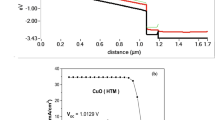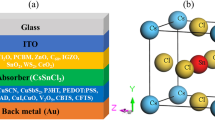Abstract
This study entails a theoretical investigation of the effect of the hole transport layer (HTL) and electron transport layer (ETL) materials on a lead-free perovskite solar cell based on methylammonium tin iodide (CH3NH3SnI3). The simulations of the solar cells were conducted with the aid of the one-dimensional solar cell capacitance simulator, SCAPS-1D. The initial primary cell with the following architectural design: glass/FTO/WS2/CH3NH3SnI3/P3HT/Au, was simulated to yield a modest power conversion efficiency (PCE) of 10.47%. In an attempt to improve the PCE of this device, several materials were tested as the HTL, and their effects on the PCE were simulated. Subsequently, various ETL materials were tested with what were found to be the best possible HTL materials. The PCE of the primary device increased from 10.47% to over 16% with the utilization of 2,2′,7,7′-tetrakis [N,N-di(4-methoxyphenyl)amino]-9,9′-spirobifluorene (spiro-OMeTAD), copper(I) oxide (Cu2O), copper(I) thiocyanate (CuSCN), copper(I) iodide (CuI), and poly(2,5-bis(3-tetradecylthiophen-2-yl)thieno-[3,2-b]thiophene) (D-PBTTT-14) as HTLs. Tungsten disulfide (WS2) was shown to be the best suitable ETL material. The density of defects of the absorber for the devices with tungsten disulfide as the ETL and Cu2O, D-PBTTT-4, CuSCN, spiro-OMeTAD, and CuI as the HTLs, was best at 1.5 × 1017 cm−3, while for the primary device, the best value of the density of defects was 1.5 × 1014 cm−3. Furthermore, the energy barriers at the interface for primary and optimum devices was examined. Additionally, the effect of the external operating temperature on the performance of the devices was investigated. The simulation results allow one to propose the best HTL and ETL materials for high performance of lead-free perovskite solar cells, based on tin.










Similar content being viewed by others
Code availability
The code used is available.
References
Ahmadi, M.H., Ghazvini, M., Alhuyi Nazari, M., Ahmadi, M.A., Pourfayaz, F., Lorenzini, G., Ming, T.: Renewable energy harvesting with the application of nanotechnology: a review. Int. J. Energy Res. 43(4), 1387–1410 (2019). https://doi.org/10.1002/er.4282
Lau, D., Song, N., Hall, C., Jiang, Y., Lim, S., Perez-Wurfl, I., Ouyang, Z., Lennon, A.: Hybrid solar energy harvesting and storage devices: the promises and challenges. Mater. Today Energy 13, 22–44 (2019). https://doi.org/10.1016/j.mtener.2019.04.003
Liang, Y., Yu, L.: Development of semiconducting polymers for solar energy harvesting. Polym Rev (Phila Pa) 50(4), 454–473 (2010). https://doi.org/10.1080/15583724.2010.515765
https://www.nrel.gov/pv/assets/pdfs/best-research-cell-efficiencies.20190802.pdf. Accessed 04 Dec 2020
Petrović, M., Chellappan, V., Ramakrishna, S.: Perovskites: solar cells and engineering applications–materials and device developments. Sol. Energy 122, 678–699 (2015). https://doi.org/10.1016/j.solener.2015.09.041
Cheng, P., Wu, T., Liu, J., Deng, W.-Q., Han, K.: Lead-free, two-dimensional mixed germanium and tin perovskites. J. Phys. Chem. Lett. 9(10), 2518–2522 (2018). https://doi.org/10.1021/acs.jpclett.8b00871
Hebig, J.-C., Kühn, I., Flohre, J., Kirchartz, T.: Optoelectronic properties of (CH3NH3) 3Sb2I9 thin films for photovoltaic applications. ACS Energy Lett. 1(1), 309–314 (2016). https://doi.org/10.1021/acsenergylett.6b00170
Lyu, M., Yun, J.-H., Cai, M., Jiao, Y., Bernhardt, P.V., Zhang, M., Wang, Q., Du, A., Wang, H., Liu, G.: Organic–inorganic bismuth (III)-based material: a lead-free, air-stable and solution-processable light-absorber beyond organolead perovskites. Nano Res. 9(3), 692–702 (2016). https://doi.org/10.1007/s12274-015-0948-y
Noel, N.K., Stranks, S.D., Abate, A., Wehrenfennig, C., Guarnera, S., Haghighirad, A.-A., Sadhanala, A., Eperon, G.E., Pathak, S.K., Johnston, M.B.: Lead-free organic–inorganic tin halide perovskites for photovoltaic applications. Energy Environ. Sci. 7(9), 3061–3068 (2014). https://doi.org/10.1039/C4EE01076K
Gupta, S., Bendikov, T., Hodes, G., Cahen, D.: CsSnBr3, a lead-free halide perovskite for long-term solar cell application: insights on SnF2 addition. ACS Energy Lett. 1(5), 1028–1033 (2016). https://doi.org/10.1021/acsenergylett.6b00402
Tsai, C.-M., Wu, H.-P., Chang, S.-T., Huang, C.-F., Wang, C.-H., Narra, S., Yang, Y.-W., Wang, C.-L., Hung, C.-H., Diau, E.W.-G.: Role of tin chloride in tin-rich mixed-halide perovskites applied as mesoscopic solar cells with a carbon counter electrode. ACS Energy Lett. 1(6), 1086–1093 (2016). https://doi.org/10.1021/acsenergylett.6b00514
Kamat, P.V., Bisquert, J., Buriak, J.: Lead-free perovskite solar cells. ACS Energy Lett. 2(4), 904–905 (2017). http://pubs.acs.org/journal/aelccp
Yang, G., Tao, H., Qin, P., Ke, W., Fang, G.: Recent progress in electron transport layers for efficient perovskite solar cells. J. Mater. Chem. A 4(11), 3970–3990 (2016). https://doi.org/10.1039/C5TA09011C
Chen, Y., Meng, Q., Zhang, L., Han, C., Gao, H., Zhang, Y., Yan, H.: SnO2-based electron transporting layer materials for perovskite solar cells: a review of recent progress. J. Energy Chem. 35, 144–167 (2019). https://doi.org/10.1016/j.jechem.2018.11.011
Chen, H., Bryant, D., Troughton, J., Kirkus, M., Neophytou, M., Miao, X., Durrant, J.R., McCulloch, I.: One-step facile synthesis of a simple hole transport material for efficient perovskite solar cells. J. Mater. Chem. A 28(8), 2515–2518 (2016). https://doi.org/10.1021/acs.chemmater.6b00858
Kung, P.K., Li, M.H., Lin, P.Y., Chiang, Y.H., Chan, C.R., Guo, T.F., Chen, P.: A review of inorganic hole transport materials for perovskite solar cells. Adv. Mater. Interfaces 5(22), 1800882 (2018). https://doi.org/10.1002/admi.201800882
Gil, B., Yun, A.J., Lee, Y., Kim, J., Lee, B., Park, B.: Recent progress in inorganic hole transport materials for efficient and stable perovskite solar cells. Electron. Mater. Lett. 15(5), 505–524 (2019). https://doi.org/10.1007/s13391-019-00163-6
Singh, R., Singh, P.K., Bhattacharya, B., Rhee, H.-W.: Review of current progress in inorganic hole-transport materials for perovskite solar cells. Appl. Mater. Today 14, 175–200 (2019). https://doi.org/10.1016/j.apmt.2018.12.011
Ramli, N.F., Sepeai, S., Rostan, N.F.M., Ludin, N.A., Ibrahim, M.A., Teridi, M.A.M., Zaidi, S.H.: Model development of monolithic tandem silicon-perovskite solar cell by SCAPS simulation. In: AIP Conference Proceedings 2017, vol. 1, p. 020006. AIP Publishing LLC
Michael, S.: A novel approach for the modeling of advanced photovoltaic devices using the SILVACO/ATLAS virtual wafer fabrication tools. Sol. Energy Mater. Sol. Cells 87(1–4), 771–784 (2005). https://doi.org/10.1016/j.solmat.2004.07.050
Hima, A., Khechekhouche, A., Kemerchou, I., Lakhdar, N., Benhaoua, B., Rogti, F., Telli, I., Saadoun, A.: GPVDM simulation of layer thickness effect on power conversion efficiency of CH3NH3PbI3 based planar heterojunction solar cell. Int. J. Energetica 3(1) (2018). doi:https://www.ijeca.info
Niemegeers, A., Burgelman, M., Decock, K., Verschraegen, J., Degrave, S.: SCAPS manual. University of Gent (2014)
Sobayel, K., Akhtaruzzaman, M., Rahman, K., Ferdaous, M., Al-Mutairi, Z.A., Alharbi, H.F., Alharthi, N.H., Karim, M.R., Hasmady, S., Amin, N.: A comprehensive defect study of tungsten disulfide (WS2) as electron transport layer in perovskite solar cells by numerical simulation. Results Phys. 12, 1097–1103 (2019). https://doi.org/10.1016/j.rinp.2018.12.049
Kanoun, A.-A., Kanoun, M.B., Merad, A.E., Goumri-Said, S.: Toward development of high-performance perovskite solar cells based on CH3NH3GeI3 using computational approach. Sol. Energy 182, 237–244 (2019). https://doi.org/10.1016/j.solener.2019.02.041
Kumar, A., Singh, S.: Numerical modeling of lead-free perovskite solar cell using inorganic charge transport materials. Mater. Today (2020). https://doi.org/10.1016/j.matpr.2020.02.545
Hima, A., Lakhdar, N., Benhaoua, B., Saadoune, A., Kemerchou, I., Rogti, F.: An optimized perovskite solar cell designs for high conversion efficiency. Superlattices Microstruct. 129, 240–246 (2019). https://doi.org/10.1016/j.spmi.2019.04.007
Azri, F., Meftah, A., Sengouga, N., Meftah, A.: Electron and hole transport layers optimization by numerical simulation of a perovskite solar cell. Sol. Energy 181, 372–378 (2019). https://doi.org/10.1016/j.solener.2019.02.017
Jahantigh, F., Safikhani, M.J.: The effect of HTM on the performance of solid-state dye-sanitized solar cells (SDSSCs): a SCAPS-1D simulation study. J. Appl. Phys A 125(4), 276 (2019). https://doi.org/10.1007/s00339-019-2582-0
Kanoun, M.B., Kanoun, A.-A., Merad, A.E., Goumri-Said, S.: Device design optimization with interface engineering for highly efficient mixed cations and halides perovskite solar cells. Results Phy 20, 103707 (2021). https://doi.org/10.1016/j.rinp.2020.103707
Pauwels, H.J., Vanhoutte, G.: The influence of interface state and energy barriers on the efficiency of heterojunction solar cells. J. Phys. D Appl. Phys. 11(5), 649–667 (1978). https://doi.org/10.1088/0022-3727/11/5/009
Lakhdar, N., Hima, A.: Electron transport material effect on performance of perovskite solar cells based on CH3NH3GeI3. Opt. Mater 99, 109517 (2020). https://doi.org/10.1016/j.optmat.2019.109517
Cuddihy, E., Coulbert, C., Gupta, A., Liang, R.: Electricity from photovoltaic solar cells: flat-plate solar array project final report. Volume VII: Module encapsulation. (1986). https://resolver.caltech.edu/JPLpub86-31-volumeVII
Acknowledgments
N.R. is grateful to the ACADEMY project No. 2017-3052/001-001 for an academic mobility scholarship to the University of Tlemcen, Algeria, where this work was carried out at the Theoretical Physics Laboratory. AEM is thankful to DGRSDT and MHESR of Algeria for financial support under the PRFU research project N° B00L02UN130120180011. The authors are appreciative for the research support provided by the National Research Foundation (NRF) of South Africa, under grant numbers 103979 and 109580; the University of KwaZulu-Natal (UKZN), the UKZN Nanotechnology Platform, and the Eskom Tertiary Education Support Programme (TESP).
Author information
Authors and Affiliations
Corresponding author
Ethics declarations
Conflict of interest
The authors declare no conflict of interest.
Availability of data and material
Data is available from the authors on request.
Additional information
Publisher's Note
Springer Nature remains neutral with regard to jurisdictional claims in published maps and institutional affiliations.
Supplementary information
Below is the link to the electronic supplementary material.
Rights and permissions
About this article
Cite this article
Rono, N., Merad, A.E., Kibet, J.K. et al. A theoretical investigation of the effect of the hole and electron transport materials on the performance of a lead-free perovskite solar cell based on CH3NH3SnI3. J Comput Electron 20, 993–1005 (2021). https://doi.org/10.1007/s10825-021-01673-z
Received:
Accepted:
Published:
Issue Date:
DOI: https://doi.org/10.1007/s10825-021-01673-z




